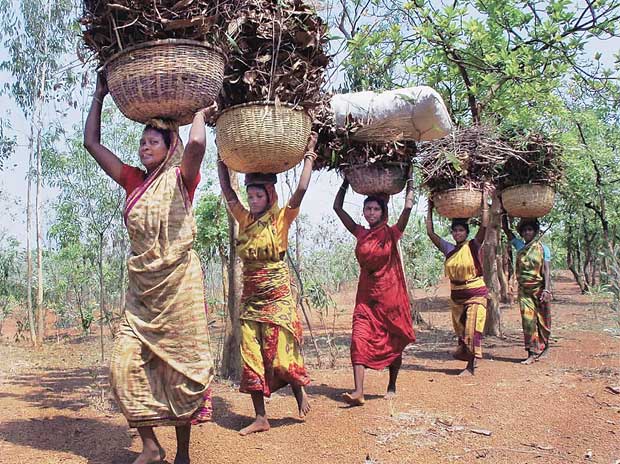In today’s global commitments towards environmental conservation, international organisations like the United Nations (UN), the International Union for the Conservation of Nature (IUCN), the European Union Forest Law Enforcement, Governance, and Trade (FLEGT) initiative, and the International Labour Organisation (ILO) are united by something more than their exemplary ideas and efforts. They are invested in securing biodiversity and climate by securing one fundamental yet largely untapped tool for conservation – the recognition of Community Forest Rights.
In order to establish the premise for Community Forest Rights, especially in India, I believe that one ought to take a brief detour to understand the history behind it. Indigenous peoples & local communities have historically been the stewards of our natural resources, which include our forests. However, this stewardship has often been misappropriated under the sole lens of common custodianship. As a result, even though indigenous peoples and local communities customarily claim and manage over 50 percent of the world’s lands, they legally own just 10 percent (Rights and Resources Institute, 2017).
In India’s colonial period when the ownership of forests was centralised, these lands came to be observed as “Unowned.” The historical stewards, indeginious people and local communities were pushed away not just from their livelihoods, but resources they had looked after for generations. What’s important to note here is that even in India’s post-colonial years, the centralized approach towards forests has remained firm; the approach is separating forests from the very people who have the greatest incentive to protect them.
This insecurity of land rights not only leads to exploitation of and violence against these local communities, but it also endangers the customs and traditional knowledge that are invaluable to the conservation of forests. Therefore, the recognition of community land rights is crucial. The essence of these is in the name itself – placing the legal ownership of lands back in the hands of communities.
Now that we understand what community forest rights are, we must also understand why they are essential. From lower rates of deforestation to better management of biodiversity, from poverty reduction to protection of indigenous and rural women’s rights, and from climate change mitigation to adaptation – the benefits are truly immense.
Realising Rights
The Rights and Resources Initiative, on September 15, 2020, published a groundbreaking analysis, titled Opportunity Framework, 2020. The idea behind this analysis was to gauge a country’s readiness to formally foster Afro-descendant peoples’, indigenous peoples’, and local communities’ rights to their land and resources through reforms. Based on the following five parameters, each country considered was scored out of fifteen:
(i) The adequacy of existing legal frameworks;
(ii) National willingness towards the aforementioned reforms;
(iii) Sub-national governments’ willingness towards the aforementioned reforms;
(iv) The government’s capacity to institute reforms;
(v) Accompanying communities’ and civil society organisations’ capacity for implementation.
India was one of the countries observed under the Opportunity Framework, being given the score of 13 out of 15 – ‘Ready for large, national, or sub-national projects to implement tenure reforms’ – owing largely to the Forest Rights Act, 2006. As defined by the Ministry of Tribal Affairs – the Forest Rights Act (FRA), 2006 recognizes the rights of the forest dwelling tribal communities and other traditional forest dwellers on forest resources. The communities were dependent on these resources for a variety of needs, including livelihood, habitation and other socio-cultural needs.
At this juncture, with the context of the benefits of local peoples’ land rights and India’s readiness for reforms, it feels nearly impossible to not ask the question – Why hasn’t it been implemented so far?
The answer is a recipe composed of one-part education and two-parts state intervention. To begin with, in about fifteen years of the Forest Rights Act, we’ve failed to disseminate, promulgate, and most importantly, realise the true potential of this historical legislation. 200 million forest dwellers across 1,70,000 villages, with community forest resources rights over 85.6 million acres of India’s forests – that is the estimated potential of a Forest Rights Act that is in full force. These figures seem even more herculean when compared to what’s been realised – only 3%. Therefore, a communication to all stakeholders about not just their rights, but also of the aforementioned potential will benefit the implementation of the Forest Rights Act multi-fold.
As far as the latter point on state intervention is concerned, one can not fail to observe that the narrative of progress with the Forest Rights Act, 2006 has been one step forward and two steps back, at best. The highlight of this retrograde has to be in the actions of several state authorities that are responsible for either the dilution or the blatant violation of the Forest Rights Act, 2006. This is done through the creation of new institutional mechanisms or the distortion of existing ones.
India has had a centralized approach towards forests, as we previously discussed. This has led to what can now only be called a deeply entrenched forest department; one that is quite unwilling to lose control of the forests of India. States continue to promulgate the creation of Joint Forest Management Committees (JFMCs), as against Community Forest Resource (CFR) rights. Community Forest Resource (CFR) rights are one of the most indispensable parts of the Forest Rights Act – it allows communities to protect and manage their customary forests; it is at the very pith of what makes conservation participatory. Therefore, giving rights to JFMCs not only emanates that overarching hesitation, but is also an overt violation of the Forest Rights Act, 2006. This is because JFMCs are controlled by the forest department, as against the CFRs, which are autonomous.
A case in point here is Andhra Pradesh, where Vana Samrakshana Samithies (VSS) were formed. Vana Samrakshana Samithies (VSS) are akin to the Joint Forest Management Committees. The transfer of rights to JFMCs or VSSs is like chasing an illusion, because they’re still not independent and technically still fall under the forest department. In addition to that, this transfer also defeats one of the main purposes of the Forest Rights Act, 2006 – giving back the land to communities that was taken away from. The intent was also to symbolise the undoing of the historical injustices against these communities.
While we’ve seen the involvement of communities and initiatives with valiant efforts, like ARCH-Vahini, that are an extraordinary aid in the process of mapping and claiming of rights, the need of the hour is speeding-up the implementation. There is no question of veracity as far as benefits of the aforementioned transfer of rights are concerned. However, in the global efforts towards conservation, to undermine Community Forest Rights would be to miss the elephant in the room altogether; it would mean undermining the global efforts towards conservation altogether.
Read more: Private investment, the holy grail for India’s recovering economy
Post Disclaimer
The opinions expressed in this essay are those of the authors. They do not purport to reflect the opinions or views of CCS.






